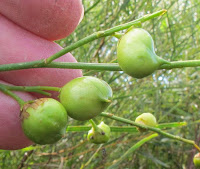Click image to enlarge
Anthocercis littorea - Yellow Tailflower
Anthocercis is one of the smaller genera of the large Solanaceae family, but contains several interesting species. Anthocercis littorea is a shrub with a liking for deep calcareous sand on stabilised tertiary dunes or over limestone, where after bushfires it will germinate prolifically to dominate hollows where it can form dense thickets. However in this congested situation it will quickly grow to 3 m (10’) in height, but largely disappear within 5 years to be replaced by other vegetation. It does survive (although shorter to around 2 metres) for many years in small-scattered colonies, particularly on more elevated positions where they reproduce from seed.
The conspicuous bright yellow, insect pollinated flowers, are commonly to 4 cm (nearly 13/4”) diameter and if conditions are not excessively dry, will continue to bloom for most of the year. The branches are very light and brittle, but remain stable to sway stiffly in strong winds that are not uncommon in their exposed coastal habitat. Shrubs have scattered pale green leaves (reputed to be toxic to stock) and tend to be open and a little untidy.
With their preference for calcareous soils they mainly occur around the coast, which they do from Israelite Bay (200 km or 125 miles east of Esperance) to Carnarvon (800 km or 500 miles north of Perth). With another 1000 km around the coast from Perth to Esperance, it makes Anthocercis littorea very widespread and well suited to its environment.





